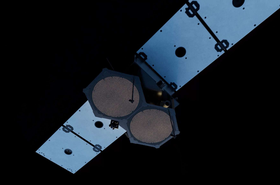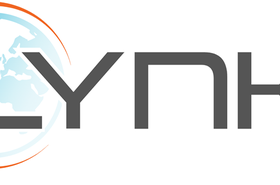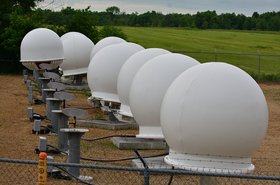European satellite operator SES is to invest in ‘cell tower in space’ satellite firm Lynk Global. Intelsat, which is merging with SES, has also invested in Lynk.
GEO & MEO operator SES announced a partnership with LEO operator Lynk this week to address high-growth in the direct-to-device (D2D) segment.
As part of the agreement, SES will provide Series B funding for Lynk Global’s D2D constellation. Terms of the investment weren’t shared.
SES will also provide a suite of integrated services that will enhance Lynk Global’s capabilities, including a relay to route traffic between LEO and SES’ MEO network, as well as a Network-as-a-Service leveraging SES’s global ground network to provide gateway access and SES’s geostationary satellites to provide Telemetry, Tracking, and Command and Monitoring (TTC & M) services.
SES and Lynk Global will collaborate in the development of Lynk's network architecture, as well as satellite manufacturing in the US and Europe.
SES will also become a channel partner of Lynk, reselling to government, telecoms, and automotive customers.
Ramu Potarazu, CEO of Lynk Global, said: “This long-term strategic collaboration with SES will deeply integrate our networks to enhance our capabilities, and validates our LEO D2D network. With access to the right satellite infrastructure and dedicated ground infrastructure through SES, we are strengthening our ability to address government, MNO, and automotive D2D use cases.”
Adel Al-Saleh, CEO of SES, added: “We recognize D2D as an exciting growth opportunity that complements our multi-orbit network to address a broader set of use cases. This partnership gives SES exposure to the D2D segment and is a key part of our strategy to diversify into this nascent, high-growth segment. SES’s multi-orbit network, particularly our MEO and ground infrastructure, will enhance the resilience, global reach, and innovation of Lynk's D2D network.”
Al-Saleh added that Lynk will be the first D2D provider to use SES’ MEO-Relay service.
SpaceNews reports Intelsat, the satellite operator currently being acquired by SES, has separately also invested in Lynk. SES’ acquisition of Intelsat is yet to close. Terms of Intelsat’s investment also were not shared.
“This really is coincidental,” Intelsat CEO David Wajsgras told SpaceNews the same day. “We were completely independent of SES, and we had our own analysis and our own logic.”
Cell-tower-in-space firm Lynk currently has five small satellites in LEO. Founded in 2017, Lynk has raised more than $100 million to date. The company is currently undergoing a SPAC merger with Slam Corp.
The company has signed commercial agreements with more than 40 MNOs covering more than 50 countries, including Spark in New Zealand, Vodafone Ghana, Globe Telecom in the Philippines, Telecel’s Centrafrique in the Central African Republic, Rogers in Canada, TPG in Australia, Telikom in Papua New Guinea, and the US government.
Lynk conducted a demonstration on the Portuguese Azores islands earlier this month in partnership with local telco MEO.
Viasat conducts direct-to-device test in South America
In other direct-to-device news, satellite operator Viasat this week announced a demonstration of D2D connectivity for the automotive sector in Brazil.
In a country-first, the tests saw different vehicles connect directly to Viasat’s L-band satellites and Skylo’s network, to provide narrowband tracking, monitoring, and messaging capabilities.
The trials took place over the last four months between Blumenau and Curitiba in Southern Brazil.
The tests, conducted by Viasat’s ecosystem partner GuardianSat, used 3GPP standards-based non-terrestrial-network (NTN) service infrastructure through Viasat’s connectivity partner, Acceleronix. Quectel’s antennas enabled the vehicles to switch between satellite and cellular networks.
Sandeep Moorthy, chief technical officer - Viasat commercial services, said: “When people think of direct-to-device they usually think about keeping cell phones connected via satellite. While that is a vital benefit, there is also a massive opportunity for the transport industry, with the economics of direct-to-device opening the door for mass-market adoption. D2D satellite connectivity has the potential to save lives when drivers are outside of cellular networks, while connected vehicles can also provide real-time data for a huge range of applications which ultimately add up to a more efficient and sustainable transport sector.”
AST partners with 2degrees
New Zealand telco 2degrees has partnered with direct-to-device satellite firm AST Spacemobile.
This collaboration aims to enhance 2degrees’ mobile coverage in New Zealand, bringing broadband data services to customers via satellite starting in 2026.
2degrees will invest in the development of its own dedicated ground station in Aotearoa (aka New Zealand).
2degrees chief executive Mark Callander said: "This partnership will extend our network reach and provide customers connectivity in places that our cellular network doesn’t serve. Our goal is to provide reliable mobile Internet connectivity beyond the limits of existing infrastructure."
Founded in 2017, AST’s first test satellite, Bluewalker 1 was launched in 2019; Bluewalker 2 was canceled. Its latest test satellite, Bluewalker 3, launched in 2022. Its first commercial satellites, BlueBirds 1-5 were launched last year.
Verizon, AT&T, and Vodafone are all investors in AST SpaceMobile and have conducted D2D tests with the company.







